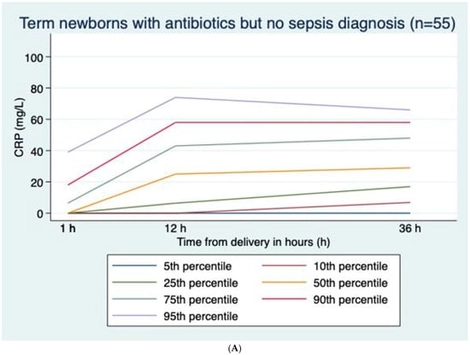- Article
C-Reactive Protein Levels of Healthy Term Infants Born After Prolonged Rupture of Membranes
- Anders Batman Mjelle,
- Vilde Solberg and
- Emma Rød
- + 5 authors
Background/Objective: Even in the absence of infection, prolonged rupture of membranes (PROM) has been associated with elevated neonatal C-reactive protein (CRP). As both the sensitivity and specificity of CRP in predicting early-onset neonatal sepsis (EOS) may be low, we aimed to describe CRP levels during the first 36 h of life in term infants born after PROM ≥ 24 h. Methods: CRP was measured at 1, 12, and 36 h. Descriptive statistics and correlation analyses were performed, taking gestational age, birth weight, sex, delivery mode, and antibiotic treatment into account. Reference CRP values in healthy neonates without sepsis born after PROM were established. Results: Median (range) CRP was 0 (0–62) mg/L, 0 (0–82) mg/L, and 4 (0–92) mg/L at 1, 12, and 36 h, respectively. CRP at 12 and 36 (p < 0.001) but not 1 h was positively correlated with gestational age and birth weight. There was no difference in CRP after C-section vs. vaginal delivery. Among infants without sepsis, CRP was higher at all time points in infants who did vs. those who did not receive antibiotics (p < 0.001). Conclusions: CRP was low in term infants without sepsis born after PROM but with outliers above 60, 80, and 90 mg/L after 1, 12, and 36 h, respectively. Research is needed on the long-term outcomes of infants with inflammation, as evidenced by an elevated CRP after PROM.
5 December 2025



